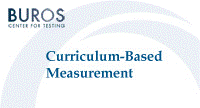Buros-Nebraska Series on Measurement and Testing

Curriculum-Based Measurement
Date of this Version
1993
Document Type
Article
Citation
Curriculum-Based Measurement, edited by Jack J. Kramer (Lincoln, NE: Buros Institute of Mental Measurements, 1993).
Abstract
The purpose of this chapter is to describe curriculum-based procedures from a broad perspective that encompasses the major models appearing in the professional literature in the past 10 years. Rather than simply review the major perspectives, operating assumptions, and implementation directives of these models, however, nine criteria are presented for a uniform comparison. These criteria were implicit in the adoption of curriculum-based measurement (CBM) in Pine County, Minnesota during the initial training and field-based research conducted in the early 1980s. Therefore, they can be used both to structure the review and to provide district personnel a focused evaluation strategy for adopting any or all components of the models.
MODELS OF CURRICULUM-BASED PROCEDURES
Curriculum-based assessment (CBA) has been variously defined in the professional literature since it was originally introduced in the early 1980s. Although many of these definitions include similar components, the differences between them are sufficient to warrant a careful examination. In part, the models can be compared by analysis of their conceptual base and assumptions, the essential features that comprise any specific model. However, a more important comparison of the models may be in the empirical and psychometric support that exists.
An immediate problem that must be resolved is agreement on a definition of curriculum-based procedures that is generic enough to encompass the various models. The key words in the phrase are "curriculum-based" and "assessment." I will confine the first term to the analysis of the materials used for measuring and evaluating student performance and the second term to the collection of information for making a decision. This second term, therefore, refers to several issues: the type of response that students make, the system for scoring and reporting performance, and the interpretations or type of decisions that can be made from the data. The only other criterion for considering a model of curriculum-based procedures is that it must be presented or described in the professional literature (with or without supporting data). With this basic definition, several major models of curriculum-based assessment can be considered. Although not all models explicitly employ the term curriculum-based assessment, they in fact represent measures of student performance that fit the basic definition above.
Gickling and Havertape (1981), Gickling and Thompson (1985), Tucker (1985), and Coulter (1985) have all written about a consistent model of curriculum-based assessment. This model is more explicitly developed in reading and mathematics, but has been extended to other areas. It is very closely linked to instructional planning for individual students with three major dimensions: (a) task type ("context" tasks and drill tasks), (b) task items (knowns, hesitants, and unknowns), and (c) performance levels (frustration, independent, and instructional).
Included in
Curriculum and Instruction Commons, Educational Assessment, Evaluation, and Research Commons


Comments
Copyright © 1993 by Buros Institute of Mental Measurements. Digital Edition Copyright © 2012 Buros Center for Testing. This book may be downloaded, saved, and printed by an individual for their own use. No part of this book may be re-published, re-posted, or redistributed without written permission of the holder of copyright.